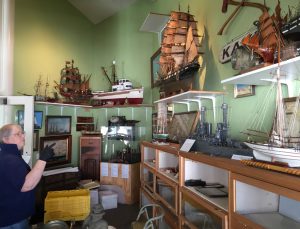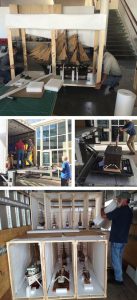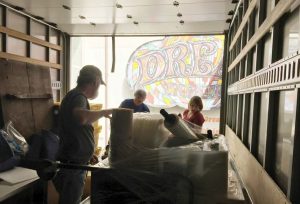By Stephen Canright and Kristen Kvam
Excerpt from the Sea Letter, Winter 2016 # 74
The decision to take in the bulk of the Allen Knight material was made in early 2016, and the paperwork authorizing the transfer was completed by mid-February. Superintendent Kevin Hendricks, Cultural Resources Chief Robbyn Jackson, and Collections Manager Keri Koehler were all quite supportive of the acquisition, realizing that it represented a truly unique opportunity to notably enrich the collections of the Maritime Park. These managers were well aware of the long-term commitment that the Park was making in taking on a collection of this size and complexity, but ultimately concluded that the Park’s mission demanded a positive response.
The arrangements for actually selecting, packing, moving, and receiving the material fell largely to the Collections Department under Keri Koehler, with notable assistance from Dave Casebolt and Eloise Warren of the Conservation Department and John Muir of the Small Boat Department. Robbyn Jackson was able to secure for $10,000 in emergency funding from the NPS Regional Office.
This paid for supplies, truck rent-als, moving services for a truck load of display cases, and for new storage cabinets for glass plates. Money was still in short supply, and ultimately it was only the very timely offer of lodgings for the crew in a beachfront home belonging to an Association Trustee, Brian Thayer Mullins, that allowed us to proceed in a reasonably efficient manner.
After a couple of quick exploratory visits, a gang of six went down to Monterey on February 22, committed to spending a full work week sorting, packing, and shipping the materials, both on exhibit and in storage. This group included Kirsten Kvam and Diane Cooper of Collections, Lisbit Bailey from Historic Documents, Taylor Horton from Photo Archives, and Dave and Eloise from the Conservation Department. John Muir drove a second big rental truck down on the 23rd, and returned with a first truck fully loaded.
Tim Thomas, representing the Monterey Museum, was on hand for the whole of the process. With his intimate knowledge of the collections, he was invaluable in assisting with the identification of pieces and n filling in the background and context of the items. A number of the items of immediate Monterey interest were given to various local institutions, including the State Parks Department, and Tim acted as referee and arbiter in see-ing that everyone got what they had been promised. With so many different people and groups struggling to deal with a confined space and a single elevator, Tim also helped to direct traffic.
Taylor Horton got right to work on the photo material, dealing particularly with the great number of glass plate negatives. These were at once notably delicate and very heavy. The negatives were already boxed, but they had to be packed carefully into double-wall cardboard boxes, and padded with many inches of foam. The boxes were then loaded on pallets to be moved into the first of the trucks. In all, there were some 1500 pounds of glass negatives. The materials also included drawers full of film negatives and scores of albums full of prints.
Lisbit Bailey worked on the bound logs and ledgers, on the books, and on the paper archives, seeing existing order maintained and everything packed according to its needs. There was little time to stop and savor the content of any of this material, but just the occasional passing glance was enough to quicken the pulse of a dedicated archivist.
Dave and Eloise took on some of the trickiest and most physically demanding work, dismantling the display of after cabin paneling and furnishings, and safely securing these often large and awkward pieces. Diane Cooper, with support from Tim Thomas, also worked on the material on exhibit, making up special travel cases to protect the great variety of pieces. Kirsten, later with help from Lisbit, concentrated on the artwork stored in flat file drawers and sorted and packed thousands of oddly assorted artifacts, from chronometers to cribbage boards. During this initial week, the ship models were only moved into an accessible location where they were photo-graphed and carefully measured. Back at home, a larger group of the staff would consider the merits of the various models and finally decide which of them to take in. Eloise and Gary Ino (from the Exhibit Shop) would then make up travel frames for the selected models, in anticipation of packing them up during a later visit.
With everyone staying at Mullins’ beach house, an exceptional level of camaraderie developed among the gang, who normally worked out of their separate shops or cubicles, often at separate ends of the Park. Dave Casebolt produced a memorable barbequed steelhead trout, with all hands helping with the other dishes. There was also some underlying sense of wistfulness in working on the dismantling of a sister maritime museum. Perhaps the tide of popular enthusiasm for maritime history was on the wane. Perhaps we had all stumbled into the wrong business. But there remained a strong sense of mission. This gang was representing an institution established by the Congress, representing the people, making use of their professional skills to insure that that the stuff of maritime history, and the values that were represented, would not be lost to time.
A three-day work party returned in mid-March to pack the models into their custom travel cases and load them aboard a final truck. There was a last flurry of sorting, selection, and packing of the remaining objects.
Then home to begin the long process of making sense of the material, integrating it into our systems, and finally making it available. Stay tuned. This will take years.



